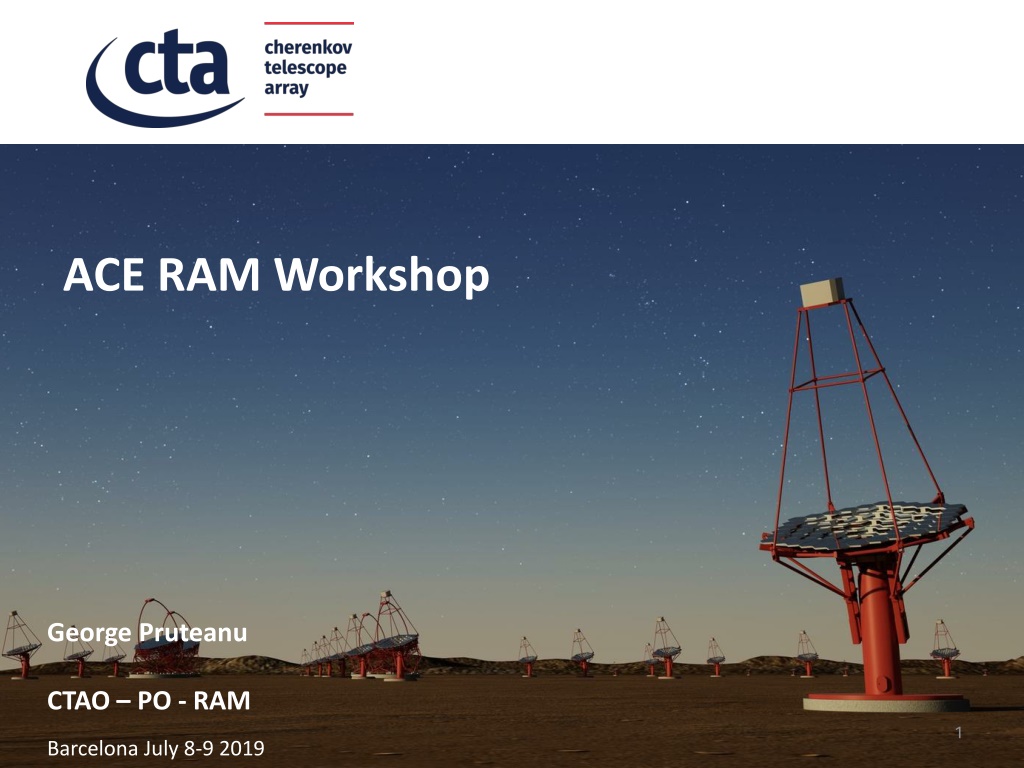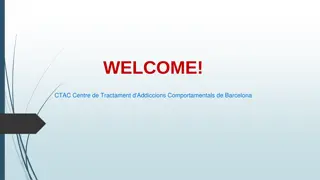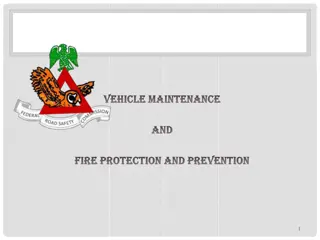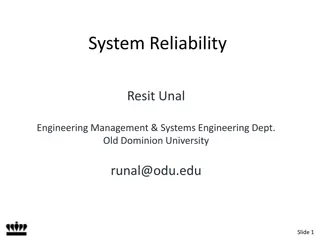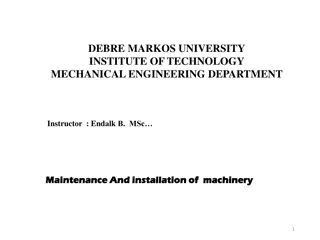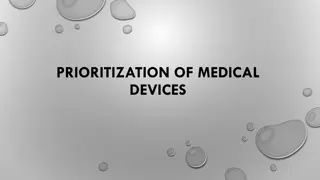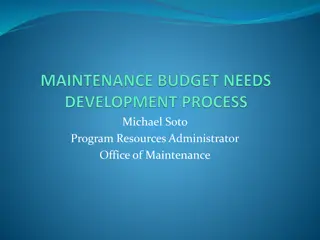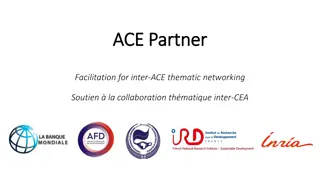ACE RAM Workshop - Barcelona 2019: Reliability and Maintenance Concepts
The ACE RAM Workshop conducted by George Pruteanu in Barcelona focused on topics such as RAM prediction, FMEA, maintenance concepts, preventive and predictive maintenance, condition monitoring systems, corrective maintenance, and design for maintenance. The workshop delved into reliability prediction using Lambda Predict, system tree building, part stress analyses, reliability modeling, environmental factors consideration, and more. The event highlighted the importance of assumptions for correction in RAM prediction to ensure the reliability of components. Additionally, the workshop covered Failure Mode and Effects Analysis procedures and system/subsystem analysis.
Download Presentation

Please find below an Image/Link to download the presentation.
The content on the website is provided AS IS for your information and personal use only. It may not be sold, licensed, or shared on other websites without obtaining consent from the author. Download presentation by click this link. If you encounter any issues during the download, it is possible that the publisher has removed the file from their server.
E N D
Presentation Transcript
ACE RAM Workshop George Pruteanu CTAO PO - RAM 1 Barcelona July 8-9 2019
Agenda: RAM Prediction (Lambda Predict) FMEA Maintenance Concept philosophy Preventive Maintenance (PM) Predictive Maintenance (PdM) Condition Monitoring System (CMS) Corrective Maintenance (CM) FLCM (BIT BITE) SLCM TLCM Design for Maintenance - Concept 2
RAM Prediction (Lambda Predict) Build System Tree (more on function than physical location). Where can be obtain, use supplier information (MTBF, FR, Sales vs. Returns in specific time etc.). Use Part Library available with Reliasoft . Reliability prediction (FIDES, Telcordia, Mil 217, NSWC-07/11) Part count and Part stress Analyses - Mil 217 (friendly user) Consider environmental and other stress factors Using BlockSim to represent the reliability model (RBD Reliability Block Diagram) of system. Lambda Predict software and Block-Sim and how to connect them. 3
RAM Prediction Assumption for correction Use "Ground, benign" as Environment Factor for components inside the camera body (assuming the camera is isolated from external conditions and it has offered a controlled temperature and humidity environment), Use "Ground, fixed" for components outside the camera body, Use 30 C as reference temperature inside the camera, when more specific values are not available, Use a Quality Factor of "M" by default (corresponding to a multiplicative factor x1.0 in the failure rate). At least for passive parts as SMD Capacitors and Resistors, it produces failure rates much closer to those predicted by Fides and Telcordia for similar parts, It is allowed to use the failures rates from the parts manufacturers when they are referred to 55 C and 60% CL (most common case), It is allowed to use reliability models from different Standards to predict the failure rate of given parts. For example, FIDES to predict failure rate of connectors and fans (more updated properties such as L10 supported). FIDES to use PI factor of 1 instead of 4. 4
FMEA Prepared By: Date: Failure Mode and Effects Analysis Name of System/Subsystem analysed Reviewed By: Date: Approved By: Date: Root Causes Identification Failure Mode Identification Failure Mode Effects Failure Management Reliability Prediction Failure Classification RPN Management New Occurence (OCC) Diagnostic/ Detection Criticality (SEV*OCC) New Detection (DET) New Severity (SEV) Effective Modal Failure Rate (Ss) Severity impact on Safety (Yes/No) (Sr) Severity impact on Reliability (Yes/No) (SPF) Single Point of Failure (Yes/No) Overall System Escalation Item Failure Rate Occurence (OCC) Next Higher Level Effect Potential Root Causes Modal Action(s) Recommended Detection (DET) Ref# (ID) Component (LRU/LLRU) Potential Failure Mode Local Effect Mitigation Comments Data Source Action(s) Taken Responsibility Resulting RPN Severity (SEV) Apportionment Actual RPN Local Central 5
Maintenance Concept philosophy CTAO basic philosophy is to have a system that requires minimum maintenance, consistent with safety and a low cost of operation. CTAO to implement Maintenance Process based on: - regular activities (i.e preventive maintenance), - condition monitoring of all major components and a - quick on-site remove/replace (R&R) of failed component. CTAO Maintenance activities: Preventive Maintenance (PM) Predictive Maintenance (PdM) and Condition Monitoring System (CMS) Corrective Maintenance (CM) 3
Preventive Maintenance (PM) A preventive maintenance program will be determined by economics or safety would result in much less emergency work and costly repairs. PM consists of check point periodic, scheduled activities on equipment: visual inspection, cabinets thermography adjustments, cleaning, lubrication (use automated process particularly in difficult to reach spots) scheduled replacements of: consumable parts (air filters, oil filters), limited life items (camera sensors??), Items subject to restoration to "as new" condition (overhaul), minor repair and maintenance of equipment and systems (cleaning mirrors, checking oil etc.). Replacement of obsolete items. 4
Predictive maintenance (PdM) and Condition Monitoring System (CMS) Goal of PdM is the ability to: collect data (essential parameters), analyze data and predict when equipment failure could occur, and, case by case followed by preventing the potential failure through regularly schedule or schedule replacement before failure. Predictive maintenance cannot exist without Condition Monitoring System (CMS), CMS correctly implemented will: Reduce: cost of asset failures and potential collateral damages to the system. Improve: equipment reliability and safety Minimize: unscheduled downtime due to catastrophic failure. maintenance time requirement for emergency spare parts Optimizes: maintenance intervals (better than manufacturer recommendations) 5
Corrective Maintenance (CM) Corrective Maintenance is based on the principle that the equipment downtime must be minimized at the first level of maintenance (FLCM) >>> minimize the time to repair /restore system functionality. Minimization is achieved by limiting fault isolation and the in-situ exchange of LRUs to fast and easy replacement. The FMEA forms the basis of the identification of the Corrective Maintenance requirement. CTAO Corrective Maintenance Activities can be done on 3 identified levels: - First Level Corrective Maintenance (FLCM) - Second Level Corrective Maintenance (SLCM) - Third Level Corrective Maintenance (TLCM) 6
First Level Corrective Maintenance (FLCM) & BITE (BIT) Two type of actions identified at FLCM: the repair/restoration at the location of the failure (i.e. connections and connectors fixes on site, resetting of the defective units of equipment performed on-site). or by the removal and replacement of the identified defective LRU/LLRU, and subsequent functional verification of the spare used). CTAO requires a design for maintenance approach and a Build in Test (BIT) would automatically flag the defective LRU (see next slide). BIT is a fault management and diagnosis equipment or software routine, which will automatically flag and pinpoint the defective LRU. BITE - Built in Test Equipment it s the extra hardware needed to eventually generate signals! BIT uses internal system hardware and software to test the system or its subsystems. CTAO requirement the BIT will be automatically triggered at the beginning and at the end of the observing cycle: BIT-ON as a condition to complete the standby state of the instrument, BIT-OFF - at the end of any observation cycle before gets in the parking position. 7
BITE Built in Test Equipment BIT is a fault management and diagnosis equipment or software routine, which will automatically flag and pinpoint the defective LRU. BIT uses internal system hardware and software to test the system or its subsystems. CTAO goals for BIT: BIT should detect 90% of all failures of the instrumentand camera. BIT must have less than 0.1% false alarms (high BIT- Equipment reliability). BIT must be design for fault detection to the LRU. CTAO requirement the BIT will be automatically triggered at the beginning and at the end of the observing cycle BIT-ON as a condition to complete the standby state of the instrument, BIT-OFF - at the end of any observation cycle before gets in the parking position. 12
Second Level Corrective Maintenance (SLCM) LRUs identified as defective at the FLCM are returned to a Central Maintenance Facility. Maintenance personnel use standard sets of second level maintenance tests and diagnostic equipment or automatic test and diagnostic equipment, to isolate and identify the defective subcomponents or parts within the defective LRU. SLCM repair action consists of the removal and replacement of the defective assemblies or parts (LLRU), with the subsequent functional verification of the replacement(s). 9
Third Level Corrective Maintenance (TLCM) TLCM is defined as repair and restoration of the LRU at a remote site, Supplier/manufacturer responsible in agreement with CTAO to repair with-in a defined time line (turnaround time-TAT) RCCA training! Information needed generate repair shop report are vital information for the Failure Reporting Analysis and Corrective Action System (FRACAS)- a failure tracking system to be implemented. All TLCM activities are recommended to be undertaken by the supplier or original manufacturer or their authorized repair and overhaul agencies. 10
Design for Maintenance Maintainability is created during the design process. It cannot be added later. Adoptmaintenance philosophy in terms of repair versus disposal of the product or components. This should be done before starting any design work. Consider where maintenance will take place (FLCM, SLCM, TLCM) Keep it simple. Complex arrangements are usually harder to maintain. Make it testable. Reactive (fault finding) tests often reveal latent problems that will become faults in the near future. Include diagnostic test points in electrical circuits. Design reliability into items that are difficult to maintain to reduce the need for maintenance access. Provide warning labels where a maintenance engineer may be exposed to danger. For example on hot or heavy items or where there is stored mechanical or electrical energy. Provide maintenance instructions and information panels if the routine is difficult to remember, and fix them as close to the point of maintenance as possible. Design equipment to fail-safe so that risk of injury to maintenance personnel is reduced. Avoid the requirement for special tools. Modularity design. Remove/replace with-out the need of removing other than belongings of the defective unit BIT is essential to ease the troubleshooting and to identify exactly the defective component 15
Thank You! Questions? 16
